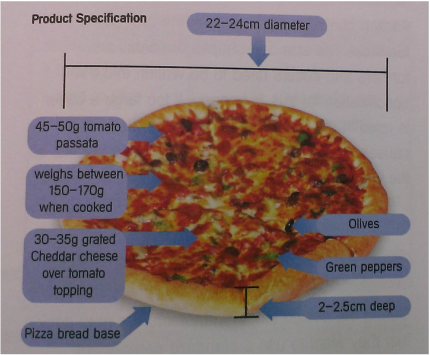Product Specification

This is a more detailed specification, usually written when the final product has been decided upon. It may be given to a chef in a test kitchen and then will undergo sensory testing before the decision is made to produce it on a large scale.
For example:
"The pastry will be rolled out to 15cm squares."
"It will contain mushrooms, sweetcorn, cheese sauce and chicken."
"It will cost between £1 and £1.50p."
Here are some ideas of what to include to produce a successful specification...
For example:
"The pastry will be rolled out to 15cm squares."
"It will contain mushrooms, sweetcorn, cheese sauce and chicken."
"It will cost between £1 and £1.50p."
Here are some ideas of what to include to produce a successful specification...
- Describe colour, texture, flavour, aroma etc...
- Specific dimensions (with a sketch) - for instance, weight, size, shape.
- Specific qualities of ingredients - for example, percentage of fat in meat, size of cherries.
- Names of ingredients with weights and proportions to use - for example, "200g butter, 450g flaked haddock."
- Specific tolerances - for example, thickness of pastry, viscosity (runniness) of sauce.
- The size to which ingredients must be cut - for example, the exact shape and size of pieces of fruit and vegetables, the nozzle size for mincing meat, the slicing grade for carrots, the grating size for cheese.
- Types of cooking methods and cooking temperatures with critical control points.
- Cooling times and methods.
- Finishing techniques - for example, "Brush with whole egg glaze before baking", "Fill centre of cake with fresh whipped cream to a thickness of 2cm", "Decorate with six slices of tomato and one teaspoonful of mixed herbs before cooking", "Cover surface of biscuit with white rolled icing to a thickness of 0.5cm."
- Specific details of packaging requirements - for example, microwavable dish with sealed film covering in crushproof sleeve."
- Wording for the label, which will provide information for the consumer about ingredients, nutrition, the name of the product, storage and cooking/reheating instructions, shelf life, etc.
- Sometimes a photograph is used to help a manufacturer to meet that specification. This would normally still need additional written information, but is useful in large-scale catering where a meal is being assembled on a plate from bought components.
- Identifiey potential allergy risks
